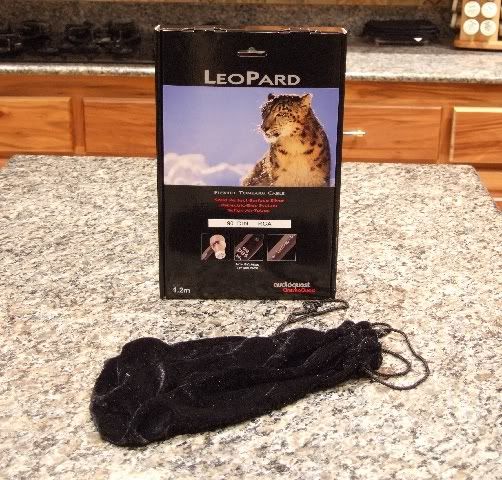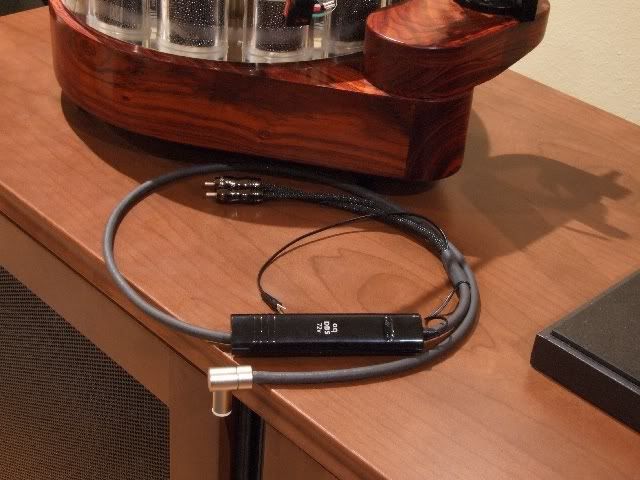A Review Of Audioquest LeoPard 72 Volt DBS Tonearm Cable

DarqueKnight
Posts: 6,765
Introduction
One good thing leads to a another in audio. This is good for your ears but can be detrimental to your wallet. Analog playback was supposed to be my sideline diversion; a necessary inconvenience due to the recordings I have that are not, and likely never will be transcribed to a digital format. The more I sneak around with analog playback, the more I feel I am being seduced by the dark side but I like it.
Based on my good experience with the Audioquest Volcano DBS speaker cable (reviewed here), I decided to try a bit of the DBS magic in my analog front end. No luck with finding a used pair of AQ LeoPard tonearm cable, even though I started shopping for the LeoPard cable well before I started shopping for the Volcano cables. My best near term acquisition option was a sympathetic dealer.

Figure 1. See the nice kitty? LeoPard tonearm cable comes in a velvet bag inside a nice glossy box with a distinguished picture of a leopard on it. Packaging of this sort makes me feel special.
Basic Statistics
The Signal Cable Silver Resolution Reference cable I formerly used is constructed of 5N stranded silver conductors with an effective wire gauge of 24 AWG and Teflon insulation. The MSRP for a 4 foot cable with a Cardas connector and silver bullet RCAs is $289.
Audioquest LeoPard tonearm cable is constructed of 5N silver conductors with highly polished surfaces and a wire gauge of 24 AWG, Teflon air tube insulation, and a 72 volt dielectric bias system (DBS). The MSRP for a 1.2 meter (3.93 foot) foot cable with silver plated RCAs is $650.

Figure 2. The dark side comes calling in the form of a new tonearm cable.
The Sound
The DBS battery pack was connected the day the cable shipped from AQ. The cable took four days to reach me; therefore, 96 of the 150 hours of specified DBS break in time had elapsed. When I first installed the LeoPard cable, it had the dull, veiled, lifeless sound I heard immediately after connecting the DBS packs to the Volcano cables. The volume of the music sounded lower (although it actually measured the same on the sound level meter) and the sound stage was scrunched down into a little area between the speakers. The bass impact, detail, and articulation I enjoyed with the Silver Resolutions was playing a sadistic game of hide and seek. The sound was somewhat like listening to my system from another room with the door partially closed.
After 120 hours, the veiling and soundstage deformities were gone and I could not tell the difference between the Silver Resolution and the LeoPard when switching back and forth. After 144 hours, the DBS magic arrived with a vengeance. The bass came back carrying a sledge hammer. Listening to David Sanborns alto saxophone on his Backstreet LP was a revelatory experience. The speed, sheer power, dynamics and clarity conveyed through the LeoPard cable was jaw dropping. To me, the CD version of Backstreet has always sounded like a cheap imitation of the LP. It sounded even more cheap, lifeless, and dull, when compared to the LP sound coming through the LeoPard cable. Behind the music, I could hear my turntable laughing at my SACD player.
In this case, my ears tell me that the 2.4X price of the Leopard cable over the Silver Resolution is more than justified.
Such good sound!
Addendum
A popular audio website has gone to some effort to ridicule DBS technology in general and Audioquest Corporation in particular. The website, which appears to be run by a group of meter pontiffs, informs that none of its writers have actually heard any DBS cables. Furthermore, they ridicule the technology based on a glaring misunderstanding of how the DBS system works. The patent documents and drawings, which are freely available at the US Patent Office website (Patent #7,126,055), are easily understood by anyone with basic knowledge of electronics and circuit theory. Monster Cable, Inc. obviously took AQ's DBS system very seriously. In December of 2006, Audioquest prevailed in a patent infringement lawsuit filed by Monster, Inc. (see attached news article from the Stereophile website).
One good thing leads to a another in audio. This is good for your ears but can be detrimental to your wallet. Analog playback was supposed to be my sideline diversion; a necessary inconvenience due to the recordings I have that are not, and likely never will be transcribed to a digital format. The more I sneak around with analog playback, the more I feel I am being seduced by the dark side but I like it.
Based on my good experience with the Audioquest Volcano DBS speaker cable (reviewed here), I decided to try a bit of the DBS magic in my analog front end. No luck with finding a used pair of AQ LeoPard tonearm cable, even though I started shopping for the LeoPard cable well before I started shopping for the Volcano cables. My best near term acquisition option was a sympathetic dealer.

Figure 1. See the nice kitty? LeoPard tonearm cable comes in a velvet bag inside a nice glossy box with a distinguished picture of a leopard on it. Packaging of this sort makes me feel special.
Basic Statistics
The Signal Cable Silver Resolution Reference cable I formerly used is constructed of 5N stranded silver conductors with an effective wire gauge of 24 AWG and Teflon insulation. The MSRP for a 4 foot cable with a Cardas connector and silver bullet RCAs is $289.
Audioquest LeoPard tonearm cable is constructed of 5N silver conductors with highly polished surfaces and a wire gauge of 24 AWG, Teflon air tube insulation, and a 72 volt dielectric bias system (DBS). The MSRP for a 1.2 meter (3.93 foot) foot cable with silver plated RCAs is $650.

Figure 2. The dark side comes calling in the form of a new tonearm cable.
The Sound
The DBS battery pack was connected the day the cable shipped from AQ. The cable took four days to reach me; therefore, 96 of the 150 hours of specified DBS break in time had elapsed. When I first installed the LeoPard cable, it had the dull, veiled, lifeless sound I heard immediately after connecting the DBS packs to the Volcano cables. The volume of the music sounded lower (although it actually measured the same on the sound level meter) and the sound stage was scrunched down into a little area between the speakers. The bass impact, detail, and articulation I enjoyed with the Silver Resolutions was playing a sadistic game of hide and seek. The sound was somewhat like listening to my system from another room with the door partially closed.
After 120 hours, the veiling and soundstage deformities were gone and I could not tell the difference between the Silver Resolution and the LeoPard when switching back and forth. After 144 hours, the DBS magic arrived with a vengeance. The bass came back carrying a sledge hammer. Listening to David Sanborns alto saxophone on his Backstreet LP was a revelatory experience. The speed, sheer power, dynamics and clarity conveyed through the LeoPard cable was jaw dropping. To me, the CD version of Backstreet has always sounded like a cheap imitation of the LP. It sounded even more cheap, lifeless, and dull, when compared to the LP sound coming through the LeoPard cable. Behind the music, I could hear my turntable laughing at my SACD player.
In this case, my ears tell me that the 2.4X price of the Leopard cable over the Silver Resolution is more than justified.
Such good sound!

Addendum
A popular audio website has gone to some effort to ridicule DBS technology in general and Audioquest Corporation in particular. The website, which appears to be run by a group of meter pontiffs, informs that none of its writers have actually heard any DBS cables. Furthermore, they ridicule the technology based on a glaring misunderstanding of how the DBS system works. The patent documents and drawings, which are freely available at the US Patent Office website (Patent #7,126,055), are easily understood by anyone with basic knowledge of electronics and circuit theory. Monster Cable, Inc. obviously took AQ's DBS system very seriously. In December of 2006, Audioquest prevailed in a patent infringement lawsuit filed by Monster, Inc. (see attached news article from the Stereophile website).
Proud and loyal citizen of the Digital Domain and Solid State Country!
Post edited by DarqueKnight on
Comments
-
Another nice review.
Thanks,
engtazengtaz
I love how music can brighten up a bad day. -
well done!Analog Source: Rega P3-24 Exact 2 w/GT delrin platter & Neo TT-PSU Digital Source: Lumin U2 w/Roon (NUC) DAC:T+A DAC 200 Phono Preamp: Rega Aria MK3 Preamp: Rogue RP-7 Amp: Infigo Method 6 Speakers: Joseph Audio Perspective 2, Audio Physic Tempo Plus Cables: Cardas Clear Reflection SC/IC, Shunyata PCs Misc: Shunyata Hydra Delta D6, VTI rack, GIK acoustic panels

